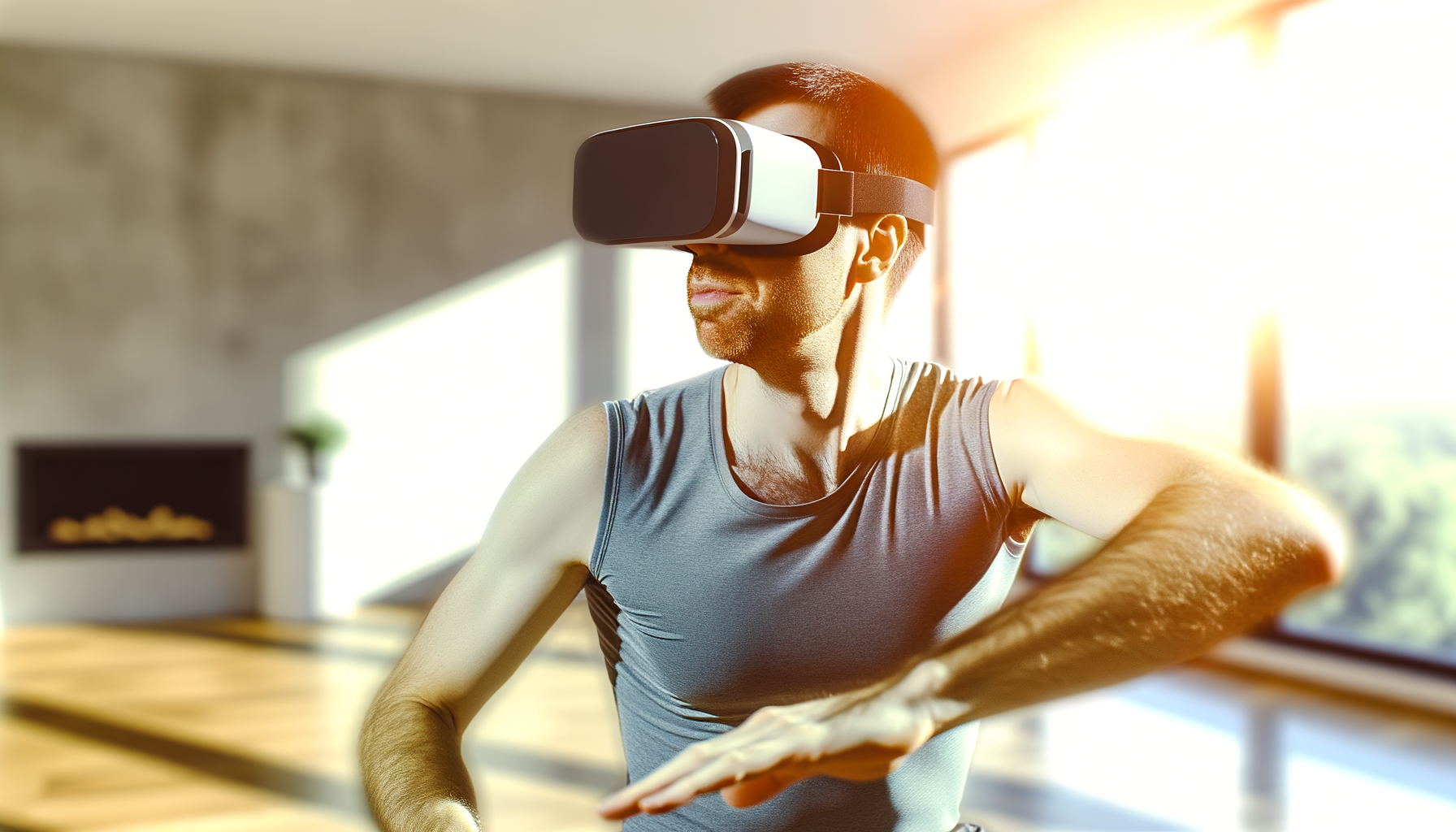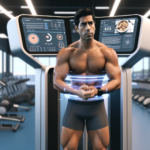
Introduction to Virtual Reality Fitness
The Evolution of Workout Regimens
Workout regimens have undergone a significant transformation over the years, evolving from traditional strength training and aerobic exercises to more dynamic and engaging formats. The latest trend in this evolution is the integration of Virtual Reality (VR) into fitness routines, offering an immersive experience that revolutionizes the way we approach physical activity.
Understanding Virtual Reality Technology
At its core, Virtual Reality is a computer-generated simulation that allows users to interact with a three-dimensional environment. Using specialized headsets and motion tracking technology, VR creates a sensory experience that can transport users to different settings, making it an ideal tool for enhancing workout sessions.
Why Virtual Reality for Fitness?
The appeal of VR for fitness lies in its ability to motivate and engage users. Unlike traditional workouts that may feel monotonous, VR workouts provide a captivating environment that can make exercise more enjoyable and less of a chore. This heightened level of engagement can lead to increased consistency and better long-term adherence to fitness routines.
The Shift from Traditional Gyms to Virtual Spaces
The fitness industry is witnessing a paradigm shift with the rise of VR. The COVID-19 pandemic has accelerated the transition towards home-based workouts, and VR has stepped in to fill the void left by gym closures. Users can now enjoy a variety of virtual fitness classes, from high-intensity interval training to peaceful yoga sessions, all from the comfort of their own homes. This shift not only caters to the growing demand for at-home fitness solutions but also opens up new possibilities for those who may have previously felt intimidated by the traditional gym environment.
The Science Behind VR Workouts
Cognitive Engagement in VR Fitness
Virtual reality (VR) fitness leverages the immersive nature of VR technology to captivate users’ attention and enhance cognitive engagement during exercise. By transporting users into engaging virtual environments, VR fitness can shift the focus away from physical exertion, making the workout experience more enjoyable and less monotonous. This cognitive distraction has been shown to increase exercise duration and intensity, as users are less preoccupied with fatigue and more immersed in the virtual experience.
Physical Benefits of VR Workouts
VR workouts offer a unique combination of entertainment and physical activity that can lead to significant improvements in cardiovascular health, strength, and flexibility. The dynamic movements required by VR exercises, such as dodging, squatting, and reaching, contribute to a full-body workout that can be tailored to various fitness levels. Additionally, the ability to track and measure performance within VR applications encourages users to push their physical limits and achieve new fitness milestones.
Psychological Advantages of Immersive Fitness
The psychological benefits of VR fitness are noteworthy. Immersive VR environments can enhance motivation and adherence to exercise routines by providing instant feedback and rewards, which are key components of gamification. This positive reinforcement can lead to a more consistent exercise habit. Moreover, VR workouts can reduce stress and anxiety, offering a mental escape from daily pressures and contributing to overall well-being.
Studies and Research on VR Fitness Efficacy
Research on the efficacy of VR fitness indicates that it can be a powerful tool for improving physical and mental health outcomes. Studies have demonstrated that VR-based exercise can lead to better improvements in balance, muscle strength, and overall fitness compared to traditional exercise alone. For instance, a systematic review published in the International Journal of Environmental Research and Public Health highlighted that VR exercise could ease fatigue, tension, and depression, while inducing calmness and enhancing quality of life. However, the review also emphasized the need for more rigorous studies to confirm these positive effects, as the current evidence base is limited by small sample sizes and varying study quality.
Types of VR Fitness Experiences
Cardiovascular VR Workouts
Cardiovascular workouts are essential for heart health and overall fitness. Virtual reality (VR) takes cardio to the next level by immersing users in environments that make the heart-pumping experience more enjoyable and less monotonous. Whether it’s cycling through the virtual Alps or running from zombies, VR cardio workouts can be tailored to any fitness level and interest, making the exercise both challenging and fun.
Strength Training in Virtual Environments
Strength training is crucial for building muscle and increasing metabolic rate. VR adds an innovative twist to traditional strength workouts by integrating resistance exercises with virtual scenarios. Users can perform squats to lift virtual weights or do lunges to move through game levels, providing motivation and context to each movement. This not only enhances the user’s engagement but also ensures proper form and technique.
Yoga and Mindfulness VR Sessions
Yoga and mindfulness practices are known for their benefits in reducing stress and improving flexibility. VR takes these practices into serene, distraction-free virtual spaces, allowing for deeper concentration and relaxation. With VR, users can practice yoga on a peaceful beach or meditate atop a mountain, creating a unique environment that promotes mental and physical well-being.
Gamified Fitness Challenges
Gamification is a powerful tool in maintaining consistent exercise habits. VR fitness apps often include gamified challenges that reward users for meeting fitness goals. These might involve completing obstacle courses, beating high scores, or unlocking new levels, providing a compelling reason to return to the workout day after day.
Social and Multiplayer VR Fitness
One of the most significant advantages of VR fitness is the ability to connect with others in a virtual space. Multiplayer VR workouts allow friends or strangers to exercise together, compete, or share encouragement, regardless of physical location. This social aspect can greatly enhance motivation and accountability, making fitness a shared and enjoyable experience.
In conclusion, VR fitness experiences offer a diverse range of options that cater to different interests and fitness goals. By leveraging the immersive and interactive nature of VR technology, users can experience fitness differently and more engagingly, potentially leading to better adherence to workout regimens and improved health outcomes.
Integrating VR into Your Fitness Routine
Setting Up Your VR Fitness Space
Before embarking on a virtual reality fitness journey, it’s essential to create a dedicated space that is both safe and conducive to movement. Start by selecting an area with enough room to accommodate full-body movements, such as lunges and stretches. Ensure the space is free of obstacles that could pose a risk during vigorous activities. High-quality VR headsets like the Oculus Quest or HTC Vive, along with motion-tracking controllers, are fundamental to a seamless VR workout experience. Position any external sensors, if required, to accurately capture your movements, enhancing the interactivity of your workouts.
Creating a Balanced VR Workout Schedule
Consistency is key in any fitness regimen, and VR workouts are no exception. To reap the full benefits, establish a regular schedule that includes a variety of VR fitness programs. Alternate between cardiovascular exercises, strength training, and flexibility sessions to ensure a well-rounded routine. Incorporate rest days to allow your body to recover. By treating your VR workouts with the same seriousness as traditional exercise, you’ll maintain motivation and see tangible progress.
Tracking Progress in Virtual Workouts
One of the advantages of VR fitness is the ability to track your progress with precision. Many VR fitness platforms offer built-in tracking features that monitor your heart rate, calories burned, and workout duration. Use this data to set goals, adjust your workouts, and stay motivated. Celebrate milestones and improvements, as these will serve as powerful motivators to keep you engaged with your VR fitness journey.
Combining VR with Traditional Workouts
While VR workouts offer a unique and immersive experience, they should complement, not replace, traditional exercise routines. Integrating VR sessions with conventional workouts can provide a comprehensive fitness program. For example, you might pair VR cardio workouts with real-world weight training or outdoor running. This combination ensures you benefit from the variety and balance necessary for overall health and fitness. Remember to start with shorter VR sessions to acclimate to the virtual environment and reduce the risk of motion sickness, gradually increasing intensity as you become more comfortable.
Overcoming Challenges and Limitations
Dealing with Motion Sickness
One of the primary challenges faced by users of virtual reality (VR) fitness programs is motion sickness, a condition characterized by symptoms such as nausea, dizziness, and discomfort. This occurs due to the disconnect between visual motion cues and the body’s sense of movement. To mitigate this, users are advised to start with short VR sessions and gradually increase duration as they acclimate. Developers are also continuously refining VR software to reduce latency and improve frame rates, which are crucial factors in minimizing motion sickness.
Safety Considerations in VR Fitness
Ensuring safety during VR workouts is paramount. Users must create a clear, obstacle-free space to move around safely. It’s also important to use wrist straps to prevent controllers from slipping out of hands during vigorous activities. Manufacturers and fitness professionals are working together to establish safety protocols, such as virtual boundaries within the VR environment that alert users when they are too close to real-world obstacles.
Accessibility and Cost Factors
While VR fitness offers innovative workout experiences, cost and accessibility remain significant barriers. High-quality VR equipment can be expensive, and not everyone has the space at home to use it effectively. To address this, some companies offer rental services or more affordable VR headsets. Additionally, community centers and gyms are beginning to incorporate VR equipment, making it more accessible to a broader audience.
Staying Updated with VR Fitness Trends
The VR fitness industry is rapidly evolving, with new apps and updates released regularly. Users and fitness professionals must stay informed about the latest trends and best practices. This can be achieved through continuous learning, subscribing to industry newsletters, and participating in online forums. By staying updated, users can ensure they are getting the most effective and enjoyable VR fitness experiences.
In conclusion, while VR fitness presents a few challenges, they are not insurmountable. With the right approach and ongoing advancements in technology, VR has the potential to become a staple in fitness regimens, offering users an engaging and effective way to achieve their health and wellness goals.
Success Stories and Testimonials
Transformations and Achievements
The rise of virtual reality (VR) in fitness has not only revolutionized workout regimens but also produced remarkable success stories. Individuals who once struggled with traditional exercise routines have found new motivation and results within virtual environments. The immersive nature of VR workouts has led to significant transformations, both physically and mentally, for many users. From shedding pounds to building endurance, the achievements are as diverse as the virtual landscapes they occur in.
The Motivational Aspect of VR Fitness Success
One of the key factors in the success of VR fitness is its motivational aspect. The gamification of exercise, where users can earn points, beat levels, or compete with others, provides a compelling reason to return to the virtual gym. Testimonials often highlight how VR workouts turn the monotony of exercise into an engaging experience, with users looking forward to their next virtual challenge. This shift in perception is crucial, as it transforms the act of working out from a chore to a desirable activity.
Long-term Benefits and Lifestyle Changes
The long-term benefits of VR fitness extend beyond the immediate gratification of a game well played. Users report sustained lifestyle changes as a result of their VR workout routines. The convenience and accessibility of VR mean that users can incorporate regular exercise into their lives without the barriers of travel time and gym intimidation. Moreover, the social elements of VR fitness, such as multiplayer modes and online communities, foster a sense of camaraderie and accountability, further supporting a lasting commitment to health and wellness.
In conclusion, VR fitness has not only provided a novel way to experience exercise but has also cultivated a platform for success stories that inspire and motivate. As VR technology continues to evolve, the potential for transformative fitness journeys grows, promising a future where fitness is not just a physical pursuit but an immersive adventure.
The Future of Fitness with Virtual Reality
Emerging Trends in VR Fitness
As we look toward the horizon of fitness technology, Virtual Reality (VR) is rapidly becoming a pivotal player in shaping how we exercise. The immersive nature of VR has given rise to a new wave of workout experiences that are not only effective but also exhilarating and engaging. One of the most notable trends is the gamification of fitness, where users can immerse themselves in environments that transform mundane exercises into exciting adventures. From shadow boxing with virtual opponents to scaling virtual mountains, the possibilities are endless and ever-expanding.
Another trend is the social aspect of VR workouts. Platforms are now offering multiplayer experiences, allowing friends or even strangers to workout together in a virtual space. This not only adds a layer of motivation but also creates a sense of community, which is often a key factor in maintaining a consistent exercise routine. Additionally, we are seeing a rise in VR fitness applications that cater to specific workout styles, such as yoga, pilates, and high-intensity interval training (HIIT), making VR workouts more accessible and tailored to individual preferences.
Potential Developments in VR Technology
The future of VR technology in fitness is poised for significant advancements. One area of development is haptic feedback, which could provide tactile sensations that mimic real-world resistance and textures, enhancing the realism of VR workouts. Imagine feeling the tension of a virtual resistance band or the impact of a punch on a virtual boxing bag; this level of interaction could revolutionize the way we perceive virtual workouts.
Another exciting development is the integration of biometric sensors within VR headsets. These sensors could track heart rate, body temperature, and even muscle engagement, providing a comprehensive overview of one’s workout performance and health metrics. This data could then be used to personalize workout programs, adjust difficulty levels, and provide feedback on form and technique.
Moreover, advancements in AI-driven virtual trainers are expected to become more sophisticated, offering real-time coaching and adjustments to workouts based on the user’s performance. This personalized approach could lead to more effective and safer workouts, ensuring that users are exercising correctly and reaching their fitness goals efficiently.
The Role of VR in Future Health and Wellness
VR’s role in health and wellness is set to expand beyond the realm of physical fitness. With its ability to create immersive environments, VR has the potential to address mental health by providing stress-relieving experiences, such as virtual meditation and mindfulness sessions. It could also play a role in rehabilitation, where VR environments can be used to safely simulate physical activities for those recovering from injuries or with limited mobility.
The inclusivity of VR fitness is another aspect that will continue to grow. With workouts that can be adapted for different skill levels and physical abilities, VR can help bridge the gap in accessibility, allowing more people to engage in regular physical activity. This democratization of fitness could have a profound impact on public health, potentially reducing the incidence of lifestyle-related diseases.
In conclusion, VR is poised to become an integral part of our fitness and wellness routines. As technology continues to advance, we can expect VR to offer more personalized, engaging, and varied workout experiences. The future of fitness with VR is not just about making exercise more enjoyable; it’s about creating a holistic approach to health that is accessible, effective, and adaptable to each individual’s needs.








